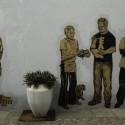
An examination on the “expanded, instrumental and decentralized character of contemporary printing and its advance to a post-printing”, is on display until February 28, at the fourth edition of the Triennale Poli/Graphic of San Juan: Latin America and the Caribbean, in the capital city of Puerto Rico. The quote is by its curator, Gerardo Mosquera Cuban, who shares the organization of the Triennale with Chilean Alexia Tala and the Puerto Rican Vanessa Hernández Gracia. San Juan has been drafting biennales for 45 years. Over the course of 13 editions between 1970 and 2002, she hosted the American Biennale of Graphic Arts, which was reformulated in 2014 by the Puerto Rican curator Mari Carmen Ramírez, director of the Fine Houston Art Museum as an exhibition that unfolds beyond one single language, changing its name to Poli/Gráfica.
Thus, in each of its recent editions, its trustees addressed issues that were based on this concept. In 2009, for example, the 2nd Triennale, in charge of Adriano Pedrosa, focused on works of artists who addressed graphic design and the production of artists’ books. “The Triennale must not forget the fact that it is the daughter of a Biennale and it should be sensitive to the strong graphic tradition of the island,” writes Mosquera, in the current edition’s brochure.
The 4th Triennale opened amidst a somewhat chaotic situation due to the delay in the release of funds that were needed for its organization, and due to the severe economic crisis faced by the country – the event is funded by public money. A week before the opening, many selected works had not yet been sent, which led Rosangela Renno to cancel her participation. Of the 55 invited artists, however, Brazil was the only one to leave the exhibition.
Even so, as expected, the works of many artists were not installed in time for the official opening on October 24, as it happened to Monica Nador and Lucia Koch, among others. As a result, a second opening was scheduled for November 18.

One of the novelties of this edition was the use of exhibition spaces of several museums throughout the island. “All the places we contacted were receptive to our proposal to decentralize the exhibition and thus occupy eight other museums, plus the Old Arsenal,” said Mosquera, who was responsible for the 2013 Panorama of Brazilian Art of MAM in Brazil.
Three artists had good retrospective shows of his work, as the Cuban Carlos Garaicoa, who displayed 26 works created between 1993 and 2014, one of the highlights of the opening. These works are composed of diptychs, usually an image of Cuba and a poetic revisitation of the image. The works of Peruvian Fernando Bryce and Puerto Rican engraver Myrna Báez were also displayed on retrospective shows.
The Triennale also occupies public spaces. Among the highlights are the billboards of the Cuban Félix González Torres (1957 to 1996). “It’s the first time they are displayed here. Felix was born in Cuba, but spent his teenage years and began his training in art in Puerto Rico,” says the curator.
Also on display on streets of the old part of Puerto Rico is the collective Grabadores por Grabadores. The group has a tradition with public interventions, usually flyposting portraits of people in real scale on the facades of the buildings. In this Triennale, the 21 artists in the collective pay tribute to artists who have used engravings in their work, as Andy Warhol and Liliana Porter, among others.
This is in fact one of the few times that the Triennale relates directly with the context. Titled Imagens Fora do Lugar/Imagens no Espaço, the exhibition features mostly works that address art-related issues, a rather conservative approach adopted by the exhibition. A show that proposes to address such a current theme as the mass production of images that torn monopolies, including art itself, could have been bolder.
This issue, however, was widely discussed at a seminar on A Imagem Contemporânea: do Espaço Simbólico como Hegemonia ao Espaço Simbólico como Problematização, featuring excellent interventions of the Chilean artist Alfredo Jaar and Mexican Cuauthémoc Medina. Jaar, for example, in addition to pointing out how his work seeks to rethink the use of the image from an ethical perspective, addressed how the photograph of the immigrant boy Aylan Kurd eventually caused an upheaval in the way Europeans face migration-related issues. Despite the abundance of images in this world, some are still shocking.
4th Poli/graphic Triennial of San Juan
Latin America and the Caribeans
Through February 28
Institute of Puerto Rican Culture
trienalsanjuan.com

Deixe um comentário